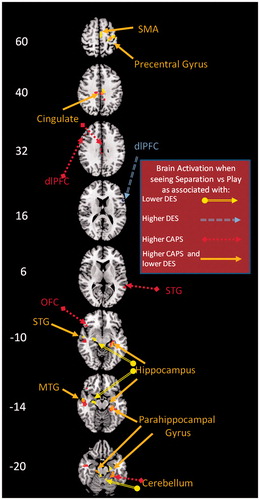Figures & data
Table 1. Multiple regression of the BOLD contrast while mothers with interpersonal violence-related post-traumatic stress disorder (IPV-PTSD; n = 11, df = 8) are watching their child during separation as compared to play, including their dissociative and PTSD symptom severity as predictors. Only significant effects are shown. “tDES” stands for the predictive t-value that is related to the Dissociative Experiences Scale (DES), “tCAPS” for the predictive t related to the Clinician Administered PTSD Symptom Scale (CAPS). XYZ describes the coordinates of the peak voxel within the Montreal Neurological Institute (MNI) coordinate system (Ashburner et al., Citation1997). The table also shows the partial correlation of the cluster with the DES-score (as corrected for CAPS values), and for the CAPS-score (as corrected for DES values) followed by the same cluster's partial correlations with separation and play.
Figure 1. Results of a multiple regression of the participants' DES and CAPS scores with BOLD activity as the dependant variable. BOLD activity refers to mothers' viewing excerpts of their own children during separation as compared to play. Code: additional activation associated with higher DES scores: double line perforated arrow (blue); with lower DES scores: double line arrow (yellow); with higher CAPS scores: single line perforated arrow (red); with higher CAPS scores and lower DES scores: single line arrow (orange). Numbers on the left side indicate the z-level within the Montreal Neurological Institute (MNI) coordinate system (Ashburner et al., Citation1997). OFC = Orbitofrontal Cortex, dlPFC = dorsolateral Prefrontal Cortex, MTG = Middle temporal Gyrus, STG = Superior Temporal Gyrus, SMA = Supplementary Motor Area.
